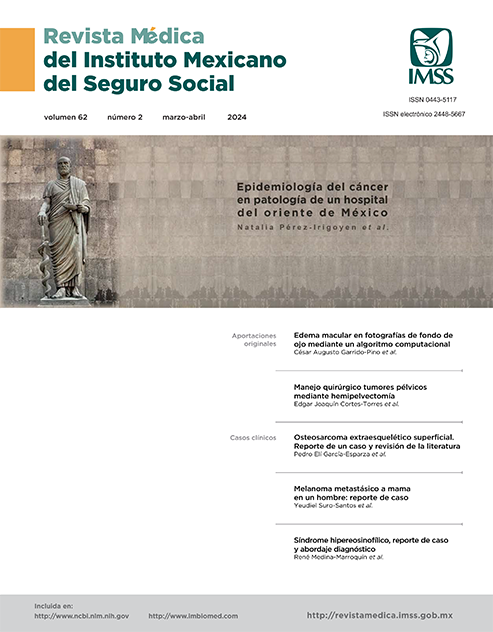Hernia umbilical y evolución clínica de pacientes con atresia de vías biliares
##plugins.themes.themeEleven.article.main##
Palabras clave
Atresia Biliar, Hernia Umbilical, Hipertensión Portal
Resumen
Introducción: la atresia de vías biliares (AVB) es la causa principal de cirrosis en niños. Su alta morbimortalidad se explica por sus complicaciones incluyendo el sangrado de tubo digestivo (STD) e hipertensión portal. La hernia umbilical (HU) se ha asociado embriológica y clínicamente con la hipertensión portal y cirrosis; se desconoce la evolución clínica en los pacientes con ABV y presencia de HU, por lo que se tuvo como objetivo describir este vínculo.
Objetivo: determinar la prevalencia de la coexistencia de AVB y HU en pacientes de un hospital de tercer nivel, y describir la evolución clínica de estos pacientes con respecto a la presencia/ausencia de HU como estrategia en la búsqueda de factores pronósticos de morbimortalidad.
Material y Métodos: este es un estudio observacional, descriptivo, retrospectivo y longitudinal que incluyó pacientes con AVB de un hospital pediátrico de tercer nivel. Se analizaron las variables relacionadas a AVB y se describió la evolución clínica de acuerdo con la presencia o ausencia de HU.
Resultados: se incluyeron 56 pacientes con ABV de los que el 69.6% fueron mujeres. La hipertensión portal se presentó en el 80.4%, siendo la presencia de red venosa colateral, STD, ascitis y hepatomegalia los datos clínicos indirectos mayormente presentados. La frecuencia de la coexistencia de HU y AVB fue del 75%. La hipertensión portal, red venosa colateral, sangrado de tubo digestivo, ascitis y várices esofágicas pequeñas fueron las variables significativamente más prevalentes en los pacientes con HU.
Conclusiones: los pacientes con AVB tienen mayor posibilidad de desarrollo de HU y que esté asociado a una evolución más avanzada de hipertensión portal y por lo tanto sus signos asociados al igual que sus complicaciones.
Referencias
Girard M, Panasyuk G. Genetics in biliary atresia. Curr Opin Gastroenterol. 2019;35(2):73-81. Disponible en: http://dx.doi.org/10.1097/mog.0000000000000509.
Sooraj K, Shivani F, Hassan Khan M, et al. Frequency of causes of portal hypertension in children. Cureus. 2022;14(6):e25934. Disponible en: http://dx.doi.org/10.7759/cureus.25934.
Schreiber RA, Harpavat S, Hulscher JBF, et al. Biliary atresia in 2021: Epidemiology, screening, and public policy. J Clin Med. 2022;11(4):999. Disponible en: http://dx.doi.org/10.3390/jcm11040999.
Gunarathne LS, Rajapaksha H, Shackel N, et al. Cirrhotic portal hypertension: From pathophysiology to novel therapeutics. World J Gastroenterol. 2020;26(40):6111-40. Disponible en: http://dx.doi.org/10.3748/wjg.v26.i40.6111.
Cortez AR, Kassam A-F, Jenkins TM, et al. The role of surgical shunts in the treatment of pediatric portal hypertension. Surgery. 2019;166(5):907-13. Disponible en: http://dx.doi.org/10.1016/j.surg.2019.05.009.
Grammatikopoulos T, McKiernan PJ, Dhawan A. Portal hypertension and its management in children. Arch Dis Child. 2018;103(2):186-91. Disponible en: http://dx.doi.org/10.1136/archdischild-2015-310022.
van Wessel DB, Witt M, Bax N, et al. Variceal bleeds in patients with biliary atresia. Eur J Pediatr Surg. 2017; Disponible en: http://dx.doi.org/10.1055/s-0037-1603987.
Chiou FK, Ong C, Low Y, et al. Non-invasive predictors for the first variceal hemorrhage in children with biliary atresia after Kasai portoenterostomy. J Clin Exp Hepatol. 2019;9(5):581-7. Disponible en: http://dx.doi.org/10.1016/j.jceh.2019.03.005.
Singh S, Bhamre R, Shetty N, et al. Correlation of endoscopic findings with Doppler ultrasound in portal hypertension in children. Clin Exp Hepatol. 2021;7(2):191-5. Disponible en: http://dx.doi.org/10.5114/ceh.2021.106509.
Herrmann J, Petit P, Grabhorn E, et al. Liver cirrhosis in children - the role of imaging in the diagnostic pathway. Pediatr Radiol. 2023;53(4):714-26. Disponible en: http://dx.doi.org/10.1007/s00247-022-05480-x.
Bronswijk M, Jaekers J, Vanella G, et al. Umbilical hernia repair in patients with cirrhosis: who, when and how to treat. Hernia. 2022;26(6):1447-57. Disponible en: http://dx.doi.org/10.1007/s10029-022-02617-7.
Aagaard J, Jensen LI, Sørensen TI, et al. Recanalized umbilical vein in portal hypertension. AJR Am J Roentgenol. 1982;139(6):1107-10. Disponible en: http://dx.doi.org/10.2214/ajr.139.6.1107.
Chapin CA, Bass LM. Cirrhosis and portal hypertension in the pediatric population. Clin Liver Dis. 2018;22(4):735-52. Disponible en: http://dx.doi.org/10.1016/j.cld.2018.06.007.
He L, Chung PHY, Lui VCH, et al. Current understanding in the clinical characteristics and molecular mechanisms in different subtypes of biliary atresia. Int J Mol Sci. 2022;23(9):4841. Disponible en: http://dx.doi.org/10.3390/ijms23094841.
Shlomovitz E, Quan D, Etemad-Rezai R, et al. Association of recanalization of the left umbilical vein with umbilical hernia in patients with liver disease. Liver Transpl. 2005;11(10):1298-9. Disponible en: http://dx.doi.org/10.1002/lt.20579.
Hung T-H, Hsiao F-T, Tseng C-W. Umbilical hernia due to enlarged paraumbilical vein. Clin Gastroenterol Hepatol. 2011;9(9): A30. Disponible en: http://dx.doi.org/10.1016/j.cgh.2011.02.029.
Bass LM, Ye W, Hawthorne K, et al. Risk of variceal hemorrhage and pretransplant mortality in children with biliary atresia. Hepatology. 2022;76(3):712-26. Disponible en: http://dx.doi.org/10.1002/hep.32451.
Sodhi KS, Saxena AK, Khandelwal N, Dhiman RK. Giant paraumblical veins in Cruveilhier-Baumgarten syndrome. Gastrointest Endosc. 2010;72(2):435-6. Disponible en: http://dx.doi.org/10.1016/j.gie.2010.02.005.
Mikolajczyk AE, Fung J, Paul S, et al. Herniated umbilical varix in a patient with cirrhosis. ACG Case Rep J. 2019;6(8): e00151. Disponible en: http://dx.doi.org/10.14309/crj.0000000000000151.
Shi Q, Xiong K, Ding B, et al. Clinical characteristics of cirrhosis patients with umbilical vein recanalization: A retrospective analysis: A retrospective analysis. Medicine (Baltimore). 2021;100(35):e26774. Disponible en: http://dx.doi.org/10.1097/MD.0000000000026774.
Michaud M, Ranaivojaona S, Livideanu C, et al. Umbilical vein recanalization. Am J Med Sci. 2021;361(5):e41. Disponible en: http://dx.doi.org/10.1016/j.amjms.2020.07.012.
Sheikh MM, Siraj B, Fatima F, et al. Flood syndrome: A rare and fatal complication of umbilical hernia in liver cirrhosis. Cureus. 2020;12(8):e9915. Disponible en: http://dx.doi.org/10.7759/cureus.9915.
Guo C, Liu Q, Wang Y, et al. Umbilical hernia repair in cirrhotic patients with ascites: A systemic review of literature. Surg Laparosc Endosc Percutan Tech. 2020;31(3):356-62. Disponible en: http://dx.doi.org/10.1097/SLE.000000000000089131.
Shalaby A, Makin E, Davenport M. Portal venous pressure in biliary atresia. J Pediatr Surg. 2012;47(2):363-6. Disponible en: http://dx.doi.org/10.1016/j.jpedsurg.2011.11.031.
Godbole N, Nyholm I, Hukkinen M, et al. Liver secretin receptor predicts portoenterostomy outcomes and liver injury in biliary atresia. Sci Rep. 2022;12(1). Disponible en: http://dx.doi.org/10.1038/s41598-022-11140-9.
Lee JL, Jiang J. Flood syndrome. Gastroenterology Res. 2022;15(4):217-24. Disponible en: http://dx.doi.org/10.14740/gr1508.


